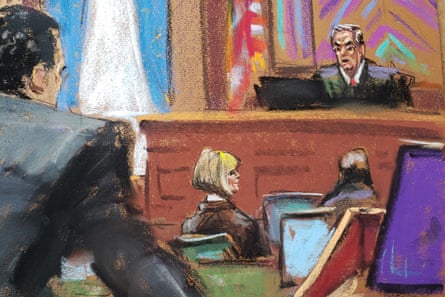Donald Trump’s lawyer told a New York jury on Tuesday that the advice columnist E Jean Carroll conspired with other women to falsely accuse the former president of rape because they “hate” him for winning the 2016 election.
The opening day of a civil trial in a Manhattan federal court heard that Carroll is suing Trump for battery and defamation “to clear her name, to pursue justice and to get her life back” after the former president allegedly raped her in a New York department store in 1996 and then denied it years later.
But Trump’s lawyer, Joseph Tacopina, told the jury of three women and six men that Carroll filed the lawsuit for political ends, to sell a book and for public attention.
Tacopina said that the rape accusation was invented by Carroll and two other women who are expected to testify that she told them about the assault shortly afterwards.
“They schemed to hurt Donald Trump politically,” he said.
Tacopina suggested to the jury that Carroll first accused then president Trump of rape after meeting George Conway, who was a vocal critic and who was married to Kellyanne Conway, one of the president’s closest aides in the White House. The judge upheld an objection to the claim by Carroll’s lawyers. It is not clear if Tacopina will return to it when Carroll gives evidence.
Carroll accuses Trump of assaulting her in a dressing room of the New York department store Bergdorf Goodman in 1996 after they ran into each other at the entrance and he asked for help in choosing a present for a friend.
Carroll sat stony-faced at the front of the courtroom as her lawyer, Shawn Crowley, told the jury that Trump manoeuvred her client into a dressing room and then attacked her. The lawyer said Trump banged Carroll’s head against the wall, pinned her arms back with one hand, pulled her tights down with the other and then rammed his fingers into her vagina.
Crowley said that Carroll kicked Trump and tried to knee him off but he was too strong for her.
“He removed his hand and forced his penis inside her,” the lawyer told the jury.
Crowley addressed what she said would be two of the biggest questions on the jurors minds. Why did Carroll go into the dressing room with Trump? And why didn’t she report the alleged rape to the police at the time?

The lawyer said that when Trump suggested Carroll try on a see-through bodysuit, she pushed it back at him and said he should be the one to try it on as it was his colour. Trump then took her by the arm and led Carroll to the dressing room.
“To her, the situation was harmless and funny,” said Crowley. “The truth is she didn’t see Trump as a threat.”
Crowley said that Carroll did tell two friends after the assault. One advised her to go to the police. The other said to keep quiet because Trump was a powerful man. Crowley said that Carroll was “filled with fear and shame” that kept her silent for decades.
“In her mind, for many years, she thought what happened to her was her fault,” Crowley told the jury.
When Carroll did decide to speak out after Trump’s election in 2016 and with the rise of the #MeToo movement, she faced a barrage of “vicious attacks” by the president.
after newsletter promotion
Crowley said that Trump’s deposition late last year will provide damning evidence against him. She noted that, in denying the alleged assault, the former president had said Carroll was not his type.
“We all know what that means. He was saying she was too ugly to assault,” the lawyer told the jury.
Crowley said that during the deposition, Trump was shown a photograph of himself meeting Carroll in the late 1980s. But he mistook the woman in the picture for his second wife, Marla Maples, who Crowley said was “very much his type”.
Trump’s lawyer, Joseph Tacopina, ridiculed Carroll’s account and accused her of abusing the justice system to express her hatred for the former president.
“You learn that E Jean Carroll can’t tell you the date she claims to have been raped. She can’t tell you the month she claims to have been raped. She can’t tell you the season. She can’t even tell you the year,” he said, pointing out that the plaintiff had previously said it was 1995 or 1996.
Tacopina told the jury that it was not believable that no one in a major department store saw Carroll and Trump together and that there were no staff in the area where the alleged assault took place. He also said that it was standard practice at Bergdorf Goodman to keep changing rooms locked until a customer asked to be let in and yet Carroll said the door was open.
Tacopina questioned Carroll’s version of why she did not call the police.
“E Jean Carroll once called the police on teenagers who vandalised her mailbox but not when she was violently raped,” he told the jury.
Earlier, the jury of three women and six men was chosen from a pool of about 100 people who were questioned about whether they could set aside their political beliefs and views of the #MeToo movement to decide the case fairly.
They were also asked if they supported Antifa, Jane’s Revenge, Redneck Revolt, the Ku Klux Klan or other extremist groups. Perhaps disappointingly for Trump and Carroll, no one in the jury pool said they followed them on social media or had read their columns or books. But nearly half had watched Trump presenting The Apprentice television programme.
The trial continues.
